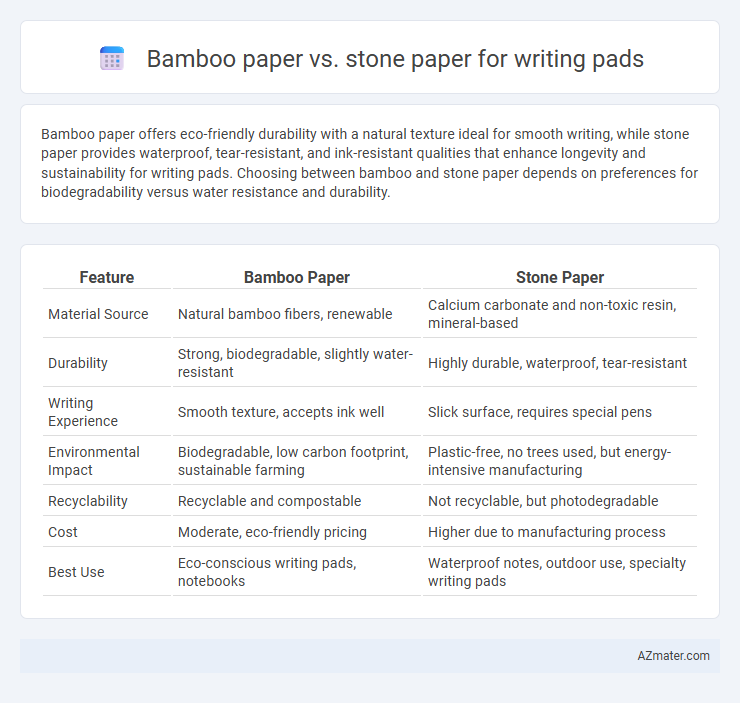Bamboo paper offers eco-friendly durability with a natural texture ideal for smooth writing, while stone paper provides waterproof, tear-resistant, and ink-resistant qualities that enhance longevity and sustainability for writing pads. Choosing between bamboo and stone paper depends on preferences for biodegradability versus water resistance and durability.
Table of Comparison
| Feature | Bamboo Paper | Stone Paper |
|---|---|---|
| Material Source | Natural bamboo fibers, renewable | Calcium carbonate and non-toxic resin, mineral-based |
| Durability | Strong, biodegradable, slightly water-resistant | Highly durable, waterproof, tear-resistant |
| Writing Experience | Smooth texture, accepts ink well | Slick surface, requires special pens |
| Environmental Impact | Biodegradable, low carbon footprint, sustainable farming | Plastic-free, no trees used, but energy-intensive manufacturing |
| Recyclability | Recyclable and compostable | Not recyclable, but photodegradable |
| Cost | Moderate, eco-friendly pricing | Higher due to manufacturing process |
| Best Use | Eco-conscious writing pads, notebooks | Waterproof notes, outdoor use, specialty writing pads |
Introduction to Sustainable Writing Materials
Bamboo paper and stone paper represent innovative sustainable writing materials designed to reduce environmental impact. Bamboo paper is made from fast-growing bamboo fibers, offering a renewable alternative with low water usage and biodegradability. Stone paper, produced from calcium carbonate and non-toxic resins, eliminates the need for trees and water, providing a durable, water-resistant option without the chemical bleaches found in traditional paper.
What is Bamboo Paper?
Bamboo paper is an eco-friendly writing pad material crafted from bamboo fibers, known for its durability, smooth texture, and biodegradability. It is highly sustainable because bamboo grows rapidly and requires minimal water or pesticides compared to traditional hardwood sources. Bamboo paper offers a natural alternative to conventional papers, providing strength and resistance to wear while maintaining an environmentally conscious footprint.
What is Stone Paper?
Stone paper is a synthetic paper made from calcium carbonate bonded with high-density polyethylene, offering a water-resistant and tear-proof surface ideal for writing pads. Unlike bamboo paper, stone paper is environmentally friendly by requiring no water or trees in its production, resulting in a smooth texture that enhances writing clarity and durability. Its unique composition provides a sustainable alternative with exceptional strength and a smooth, ink-friendly finish.
Environmental Impact: Bamboo vs Stone Paper
Bamboo paper for writing pads offers a sustainable alternative due to bamboo's rapid growth and ability to regenerate without replanting, reducing deforestation and carbon emissions. Stone paper, made from calcium carbonate and non-toxic resin, eliminates the need for water, bleach, and trees, lowering environmental pollution and resource consumption significantly. Both materials provide eco-friendly benefits, but bamboo paper excels in biodegradability, while stone paper boasts durability and a lower water footprint.
Durability and Longevity Comparison
Bamboo paper offers strong fiber composition that resists tearing and withstands regular handling, making it a durable choice for writing pads. Stone paper, made from calcium carbonate bonded with resin, boasts water resistance and tear-proof qualities that ensure longevity even in humid conditions. Both materials excel in durability, but stone paper typically outlasts bamboo paper due to its enhanced resistance to environmental factors and wear over time.
Writing Experience and Texture Differences
Bamboo paper offers a natural, slightly fibrous texture that provides a tactile, traditional writing experience ideal for pencils and pens, allowing for smooth ink absorption without smudging. Stone paper features a smoother, almost plastic-like surface with a waterproof finish that resists ink bleed, making writing crisp and clean but less absorbent, suitable for markers and gel pens. Both options deliver durability, but bamboo paper emphasizes eco-friendliness with a warm feel, whereas stone paper excels in water resistance and longevity.
Ink Compatibility and Print Quality
Bamboo paper offers excellent ink compatibility with most standard pens and inks, providing smooth absorption and vibrant print quality that resists smudging. Stone paper, made from calcium carbonate bound with resin, repels water-based inks, causing potential smearing and slower drying times, but performs well with oil-based or gel inks. Print quality on bamboo paper typically appears sharper and more consistent, while stone paper's non-porous surface may reduce clarity and detail in precision printing.
Cost and Availability in the Market
Bamboo paper typically offers a more affordable option for writing pads due to the fast-growing nature of bamboo, which makes raw materials readily available and cost-effective. Stone paper, made from calcium carbonate, tends to be pricier because of its unique manufacturing process and limited suppliers, impacting its widespread availability. Market presence favors bamboo paper for budget-conscious consumers, while stone paper appeals to niche users prioritizing durability and water resistance despite higher costs.
End-of-Life: Recycling and Biodegradability
Bamboo paper is highly biodegradable and compostable, breaking down naturally within a few months in optimal conditions, making it an eco-friendly choice for writing pads. Stone paper, made primarily from calcium carbonate, is not biodegradable but is recyclable, offering durability and resistance to water and tearing, though it requires specialized recycling processes. Choosing between bamboo and stone paper hinges on end-of-life disposal preferences, with bamboo favoring natural decomposition and stone paper supporting mechanical recycling.
Which is Better for Writing Pads: Bamboo or Stone Paper?
Bamboo paper offers a natural, eco-friendly option with a smooth texture and excellent ink absorption, making it ideal for writing pads focused on sustainability and tactile experience. Stone paper, made from calcium carbonate, provides water-resistant, tear-proof surfaces that resist smudging and are suitable for long-lasting, durable writing pads. Choosing between bamboo and stone paper depends on priorities: bamboo for biodegradability and natural feel, stone paper for durability and water resistance.

Infographic: Bamboo paper vs Stone paper for Writing pad
 azmater.com
azmater.com